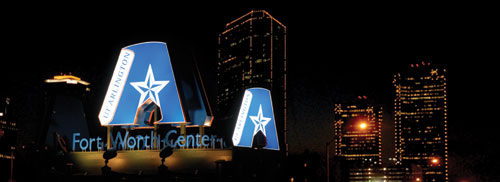CAMPUS
BUZZ
Past meets future
Fort Worth Center moves to historic Santa Fe building

Fort Worth, a place that already mingles skyscrapers and boot scrapers, is once again reinventing the past—this time, with a little help from UT Arlington.
In keeping with downtown Fort Worth’s ongoing facelift, the University recently redeveloped the 68-year-old Santa Fe freight building into the headquarters for the UT Arlington Fort Worth Center. Located at 1401 Jones St., the building was most recently the Fort Worth Rail Market, which housed a variety of shops, restaurants and a farmer’s market.
The project should further revitalize the Fort Worth transportation landmark, which dates to 1937. A major factor in choosing the building was its location, adjacent to the Intermodal Transportation Center, a hub for bus and train service. The nearby passenger depot has also been renovated.
Like many Depression-era projects, construction of the station was undertaken out of a sense of civic pride and public necessity. A delegation from the Chamber of Commerce hoped the work “would give relief to unemployment in the building trades,” which it did, employing 50-100 men for about seven months.
The building cost $123,900 in 1937. By comparison, the University’s improvements cost about $1.2 million.
UT Arlington occupies 21,000 square feet on two floors. Approximately 15,000 square feet on the first floor have been remodeled into wireless classrooms, a digital library and a student commons. The videoconferencing classroom, with wood-paneled walls and tiered seating, offers surrounding high-definition TV sets on which students weblink from as far away as China.
State Sen. Kim Brimer, Mayor Mike Moncrief and Tarrant County College Chancellor Leonardo de la Garza helped welcome the University to downtown during ceremonies in January.
“In true Maverick fashion, we’re expanding to the west,” UT Arlington President James D. Spaniolo said. “UT Arlington is always seeking to form new partnerships and find ways to serve the community. This relationship will accomplish both and bring new economic life to a beautiful facility, while expanding higher education opportunities in downtown Fort Worth.”
Fort Worth is the largest city in the United States without a public university. A recent marketing study found that people in Cowtown want education where they work.
“Last year, we surveyed businesses to determine their interest in a downtown classroom site, and the result was very positive,” said Mike West, UT Arlington Fort Worth Center executive director.
As a result, the center offers several programs for working professionals, including the Executive MBA, Professional MBA, master of science in health care administration, master of science in engineering management, bachelor of business administration in management, and continuing education classes.
Started in August, the Executive MBA is one of a handful offered in the area. EMBA students are typically upper-level executives (average age 38) who want to earn degrees without abandoning their careers. The program features a 13-day immersion trip to Beijing and Shanghai and the opportunity to network with the College of Business Administration’s China EMBA students and partner universities.
“So much can be said about this unique program and its competitive position in the marketplace,” said James Ellis, executive director of the EMBA program for the College of Business Administration. “The program is poised to become a key program of its type in Texas.”
Ellis stresses time savings and lower costs as key benefits. The program takes 15 months and costs $55,000, compared to two years and $70,000-$80,000 at several local private institutions. Classes typically are held Fridays and Saturdays, every other weekend.
The first class of EMBA-seekers has 20 executives, ages 30-52, who will continue through the program as a single class cohort. Most are mid- to high-level managers with a minimum seven years’ work experience. They come from just about every sector of the business community: health, science, marketing, finance, banking, IT and entrepreneurship. The curriculum focuses on leadership, innovation and globalization.
With more than 5,000 undergraduate and graduate students in Texas and nearly 500 graduate students in China and Asia, UT Arlington has the largest business school in Fort Worth-Dallas and the largest EMBA program in China.
Online: www.uta.edu/fortworth
— Shawn Stewart
Other Stories
Partners in discovery
Quality Enhancement Plan's pilot projects to launch this fall
Mavericks Personified: Willie Hernandez
Former Movin' Mavs star shoots for success in the wheelchair industry
Learning to serve
Many UT Arlington courses require students to perform community service. For those who enroll, it can be a life-changing experience.
Education, family style
Using their UT Arlington degrees as a foundation, the Ponce siblings fashioned successful careers in law, teaching, computing, engineering and journalism.
Morrow selected to lead women's basketball program
Contact Us
Office of University Publications
502 S. Cooper St.279 Fine Arts Building
Box 19647
Arlington, TX 76019-0647
